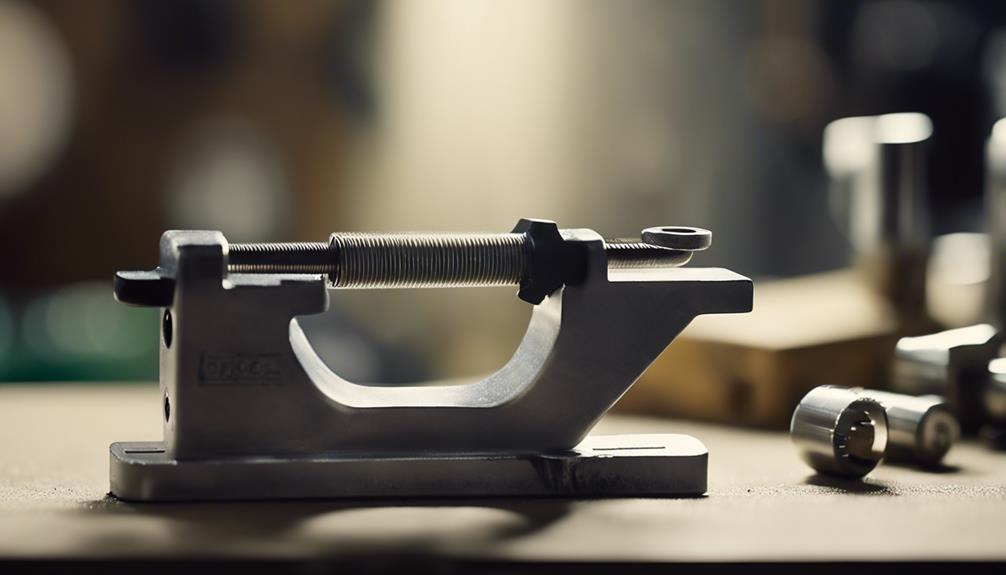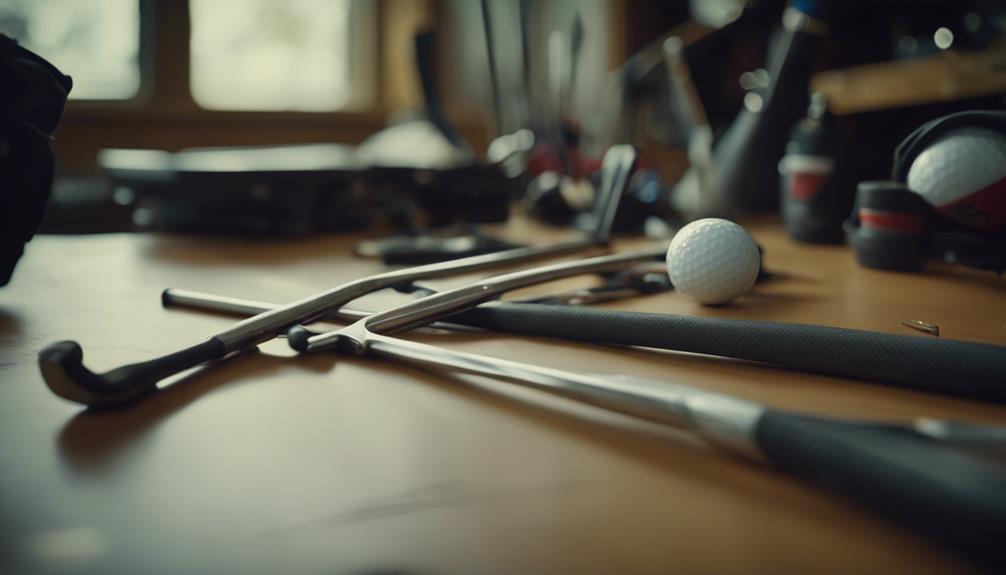- 7 Top Flite Golf Clubs XL for Improved Performance - September 28, 2024
- Top Flite Golf Clubs: Top 5 Reasons to Choose Them - September 28, 2024
- Top 3 Golf Club Fitters for a Perfect Swing - September 28, 2024
Fix your broken golf club in 5 easy steps! Start by removing old club components by lubricating the grip with White Spirit, sliding it off, and separating the head from the shaft using heat to melt the glue. Then, prepare the club head and shaft by cleaning them thoroughly and removing remaining adhesive or debris. Next, prepare a new shaft for assembly by cutting it to the correct length, deburring, and cleaning it. After that, assemble the club head and shaft using slow-dry glue, and finally, reattach the grip and inspect the club to confirm it's in good condition. Now, get ready to take your repair to the next level.
Key Takeaways
- Remove the old grip and club head by applying heat to melt the glue and sliding the grip off, taking note of its left-hand orientation.
- Clean and prepare the club head and shaft by wiping away dirt, grime, and old adhesive with a soft-bristled brush or cloth.
- Prepare the new shaft by cutting it to the correct length, deburring, and cleaning it, then applying a thin layer of epoxy to the tip.
- Assemble the club head and shaft by mixing and applying slow-dry glue, aligning the club head, and letting it set for 24 hours.
- Reattach the grip, ensuring it's properly aligned and securely fastened to the shaft, and inspect the club for damage or wear.
Remove Old Club Components
Remove the old grip from the shaft by applying White Spirit to lubricate the area, then use a specialized grip removal tool to slide the grip off, a process that allows you to reuse the grip if it's still in good condition.
This tool, costing around £20, is a worthwhile investment for any golfer looking to reshaft their club.
As you remove the grip, take note of the left-hand orientation of the grip to verify you reinstall it correctly later.
Next, focus on removing the club head from the shaft.
You'll need to apply heat around the area where the shaft meets the head using a paint stripper or heat gun.
This will melt the glue, allowing you to separate the two components.
Be patient, as this process typically takes around 3-4 minutes, depending on the club.
Once the glue is melted, you'll be able to remove the club head, leaving you with a bare shaft ready for reshafting.
With these old components removed, you're one step closer to fixing your broken golf club and getting back on the course.
Prepare Club Head and Shaft
With the old club head and grip successfully removed, you'll need to inspect the shaft and club head for any remaining adhesive or debris, thoroughly cleaning them to guarantee a secure bond with the new components. This step is vital in establishing a strong and durable connection between the shaft and club head.
To prepare the club head and shaft:
- Use a soft-bristled brush or cloth to wipe away any dirt, grime, or old adhesive from the club head and shaft.
- Apply a small amount of solvent, such as acetone or mineral spirits, to a cloth and gently rub away any stubborn adhesive or debris.
- Use a dry cloth to wipe away any remaining solvent and remove any excess moisture.
- Inspect the club head and shaft under a bright light to confirm all debris has been removed, leaving a clean surface for the new components.
Prepare New Shaft for Assembly

Prepare New Shaft for Assembly
Before assembling the new shaft, you'll need to verify it's properly prepared by cutting it to the correct length and applying a thin layer of epoxy to the tip. This guarantees a secure bond between the shaft and club head. To cut the shaft, use a shaft cutter or a hacksaw, taking care not to damage the shaft's surface. For left-handed golfers, the shaft's orientation is critical, so double-check the shaft's direction before cutting.
| Shaft Preparation Steps | Description |
|---|---|
| Cut shaft to correct length | Use shaft cutter or hacksaw to cut shaft to desired length |
| Deburr shaft | Remove any burrs or debris from the cut end |
| Clean shaft | Wipe shaft with a cloth to remove dirt and oils |
| Apply epoxy | Thin layer of epoxy on the tip of the shaft |
| Inspect shaft | Verify shaft is properly prepared for assembly
Assemble Club Head and Shaft
You're ready to attach the club head to the shaft, a critical step that requires precision and patience to guarantee a secure bond.
To strengthen a strong connection, you'll use a slow-dry, two-part glue that takes 12 hours to set. Mix the glue according to the manufacturer's instructions and apply it to the shaft, adding a little extra to the club head for added security.
Align the club head with the shaft label and leave it to set, keeping the club upright for 24 hours.
Once set, gently maneuver and bend the club to verify the shaft is securely attached.
Remove any excess glue with white spirit and a cloth, and use a Stanley knife to clean up any remaining residue.
Inspect the bond to confirm it's clean and secure, with no excess glue visible, and to corroborate that the shaft is firmly fixed in place.
Reattach Grip and Inspect Club

Now that the club head and shaft are securely attached, reattach the original grip to the club, making certain it's properly aligned and securely fastened to the shaft.
Hold the club in your left hand, with the shaft facing upwards, and carefully slide the grip onto the shaft. Make sure it's properly seated and aligned with the club's original orientation. Use a small amount of grip glue to secure the grip in place, verifying it's evenly spread and not excessive.
Once the grip is attached, inspect it to confirm it's properly aligned and securely fastened to the shaft.
Remove any excess glue or residue from the grip and shaft using White Spirit and a cloth. If necessary, use a Stanley knife to clean up any remaining excess glue or residue around the grip.
Finally, inspect the club to confirm it's in good condition, checking for any signs of damage or wear.
With the grip securely attached and the club inspected, the re-shafting process is now complete. Your broken golf club is fixed and ready for its next outing.
Frequently Asked Questions
Can You Fix a Snapped Club?
You can fix a snapped club, but it's better to prevent breaks by using proper swing techniques, storing clubs correctly, and inspecting them regularly for signs of wear, thereby avoiding costly repairs and downtime.
How Can I Restore My Golf Clubs at Home?
You're likely among the 80% of golfers who neglect regular cleaning, compromising performance. To restore your clubs, start with a deep cleaning, using a soft-bristled brush to remove dirt, then soak them in warm soapy water and dry thoroughly.
How to Glue a Golf Club Head Back On?
When gluing a golf club head back on, you'll need to master clamping techniques to guarantee a secure bond. You'll want to use a combination of clamping tools, such as vises and rubber grips, to apply even pressure.
What Epoxy Can I Use for Golf Clubs?
When you're in a pinch, don't get stuck between a rock and a hard place – opt for a slow-dry, two-part epoxy from brands like Loctite, 3M, or Devcon, which provide strong bonds for golf club assembly.
Conclusion
You've successfully breathed new life into your broken golf club! Like a phoenix rising from the ashes, your once-damaged club is now ready to take on the course.
With these 5 easy steps, you've not only saved money but also gained a sense of accomplishment.
Now, grab your revived club and get ready to sink some birdies.
Remember, a well-maintained club is a golfer's best friend – and you're now a master of club repair.




